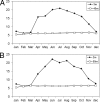Bottom-up versus top-down control of hypo- and epilimnion free-living bacterial community structures in two neighboring freshwater lakes
- PMID: 21478309
- PMCID: PMC3127590
- DOI: 10.1128/AEM.02739-10
Bottom-up versus top-down control of hypo- and epilimnion free-living bacterial community structures in two neighboring freshwater lakes
Abstract
Bacterioplankton plays a central role in the microbial functioning of lacustrine ecosystems; however, factors that constrain its structural variation are still poorly understood. Here we evaluated the driving forces exerted by a large set of environmental and biological parameters on the temporal and spatial dynamics of free-living bacterial community structures (BCS) in two neighboring perialpine lakes, Lake Bourget and Lake Annecy, which differ in trophic status. We analyzed monthly data from a 1-year sampling period at two depths situated in the epi- and hypolimnia for each lake. Overall, denaturing gradient gel electrophoresis (DGGE) revealed significant differences in the BCS in the two lakes, characterized by a higher number of bands in the oligotrophic ecosystem (i.e., Lake Annecy). The temporal dynamics of BCS differed greatly between depths and lakes, with temporal scale patterns being much longer in the mesotrophic Lake Bourget. Direct-gradient multivariate ordination analyses showed that a complex array of biogeochemical parameters was the driving force behind BCS shifts in both lakes. Our results indicated that 60 to 80% of the variance was explained only by the bottom-up factors in both lakes, indicating the importance of nutrients and organic matter from autotrophic origin in controlling the BCS. Top-down regulation by flagellates together with ciliates or viruses was found only in the hypolimnion and not in the epilimnion for both lakes and explained less than 18% of the bacterial community changes during the year. Our study suggests that the temporal dynamics of the free-living bacterial community structure in deep perialpine lakes are dependent mainly on bottom-up factors and to a lesser extent on top-down factors, whatever the specific environmental conditions of these lakes.
Figures




References
-
- Azam F., et al. 1983. The ecological role of water column microbes in the sea. Mar. Ecol. Prog. Ser. 10:257–263
-
- Boenigk J., Arndt H. 2002. Bacterivory by heterotrophic flagellates: community structure and feeding strategies. Antonie Van Leeuwenhoek 81:465–480 - PubMed
-
- Boucher D., Jardillier L., Debroas D. 2006. Succession of bacterial community composition over two consecutive years in two aquatic systems: a natural lake and a lake-reservoir. FEMS Microbiol. Ecol. 55:79–97 - PubMed
-
- Bouvier T., del Giorgio P. A. 2007. Key role of selective viral-induced mortality in determining marine bacterial community composition. Environ. Microbiol. 9:287–297 - PubMed
Publication types
MeSH terms
Substances
LinkOut - more resources
Full Text Sources

